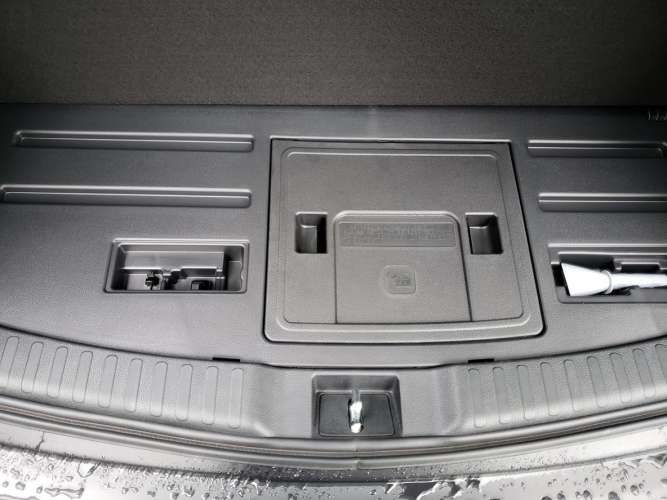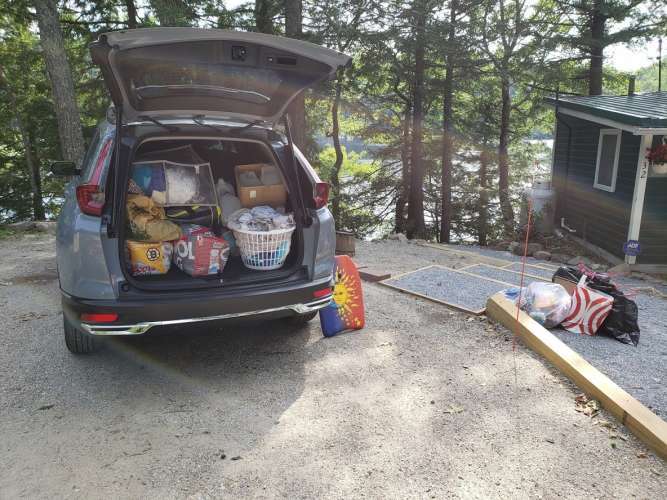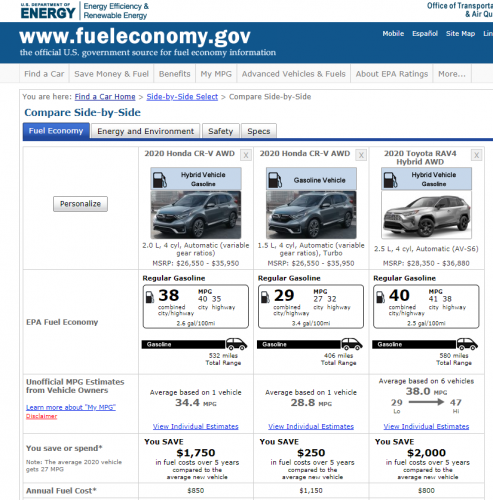This past week we had the pleasure to test one of our new favorite crossovers, the just-released 2020 Honda CR-V Hybrid. We know the CR-V very well, having tested it many times over the past few generations. This new Hybrid AWD option offers some distinct advantages over the CR-V trims that are not equipped with the hybrid drivetrain. However, the CR-V Hybrid also lacks some things.

What Is the CR-V Hybrid AWD Missing Compared To Other CR-V Trims?
Let's' cut right to the chase. The CR-V Hybrid is missing two things that other Honda CR-V crossovers have. The first is a spare tire. We understand why automakers want to save weight and money in green trims of the vehicles they market to certain audiences. However, the CR-V Hybrid is a crossover. That means it is a utility vehicle. So it is the vehicle an owner might use to take trash to the local transfer station (dump) where nails and other tire-damaging items are not unusual. It also means it travels on vacation with the family. A damaged tire away from home on Memorial Day weekend is enough of a bummer. Without a spare it can be a disaster.
The second thing missing from the CR-V Hybrid is six cubic feet of cargo volume. The non-hybrid trims all have a cargo volume capacity of 39.2 cubic feet behind the seats and 75.8 cubic feet with them folded. The Hybrid has six cubic feet less. The conventional CR-V trims offer one of the largest cargo capacities in the class. The CR-V Hybrid is mid-pack. For example, the Subaru Forester has less volume than the conventional CR-V but more than the CR-V hybrid when the seats are folded for maximum storage capability.

Will you miss the space? We did. During a family trip with two children and two adults the extra space behind the rear seats would have been very welcome. Are we picking nits? No, we don’t think so.
The third thing missing from the CR-V Hybrid is the towing specification. Can the conventionally-powered CR-V tow a small trailer? Sure it can. Up to 1,500 pounds. That is almost half its own weight. However the official CR-V Hybrid specs list the tow rating as “N/A.” That concerns us. Every crossover should be able to handle a small trailer. Perhaps the Hybrid trims can. But the vehicle is already in the hands of owners. The spec should be clear. We will translate N/A as meaning “not able.”
What Does The CR-V Hybrid Lack That Other Crossovers Offer?
We found the Honda CR-V Hybrid Touring we tested at a price of $ 35,950 was missing a few things that a consumer could get in a competitive model at that price point. For example, the U.S.-Spec CR-V Hybrid has no head-up display. You get that in a $36K Mazda CX-5. And you also get adaptive headlights (that swing from side to side).
Although the CR-V line has available Android Auto and Apple CarPlay in most trims (all but the LX), it requires that you plug in your phone using a cable to make it work. Other brands (Like Hyundai, GM, BMW, and others) have moved beyond that, and now offer wireless connectivity of this type.
Subaru Foresters and Toyota RAV4s that cost $36K also have available off-road features that the CR-V line lacks. For example, dual X-Mode in the Subaru Forester, and Hill Descent Control in both the RAV4 and Forester. We use those features in vehicles on rural roads in New England, and they have a real value to buyers with cottages and cabins in the boonies.
The Big Upsides To The CR-V Hybrid AWD
OK, so we got the short list of things the Honda CR-V Hybrid is missing out of the way. What exactly does an owner of this green crossover get? A lot, in our opinion. Let’s take a 30,000 foot view of the hybrid drivetrain rather than dive into the minutia. This drivetrain is smooth, nearly silent, pulls strongly in normal driving, and delivers outstanding fuel economy for an AWD crossover this size.
The Hybrid drive is like most of its type. There is no plug, because this is a hybrid, not a plug-in hybrid or battery electric vehicle. You simply pump gas into it and drive it like any other conventional vehicle. The CR-V Hybrid does all the work for you delivering outstanding MPG. In our testing on highway and rural suburban roads, the CR-V Hybrid Touring AWD beat its EPA Highway estimate of 35 MPG by 1 mile per gallon. However, it fell a bit shy of the “Combined” estimate. That said, we were not really testing it in the “Combined” cycle which includes urban traffic. Urban stop and go traffic actually adds mileage to hybrids like the CR-V Hybrid.

We have recently driven both a Subaru Forester and a Mazda CX-5 on this same route and recorded mileage just under 30 MPG. Therefore, the CR-V Hybrid tops these two by about 20%. That is significant. Also, the CR-V Hybrid will cost its owner about $300 per year less for fuel than the CR-V trims equipped with its 1.5-liter turbocharged engine. So, over 10 years, the Hybrid puts about $3,000 in fuel savings back in your pocket. The hybrid trims cost about $1200 more than the non-hybrid equivalents trims, so figure the savings over ten years are around $2,000. That is still a meaningful number, assuming Honda’s discounts for the standard and Hybrid trims match up.
What we really think matters more is the refinement of the CR-V Hybrid’s drivetrain and the EV-Mode that the CR-V Hybrid offers. We found the CR-V Hybrid to be super smooth in normal driving. Pull out from a stop and accelerate assertively and the CR-V Hybrid has a satisfyingly-strong pulling sensation as its two-motor hybrid drivetrain works in sync to deliver maximum torque and power. More so than a Forester or Nissan Rogue offers. Is the Hybrid drivetrain better than the CR-V’s conventional 1.5-liter turbocharged engine? It is a toss-up. We love that Honda engine too.
We do prefer using EV-Mode in hybrids and plug-in hybrids when practical, and the CR-V Hybrid does not disappoint. Without our taking any action, the CR-V Hybrid pulled our test vehicle up a long steep hill on a dirt road at a moderate pace using only EV-Mode. In urban traffic, parking lots, and drive-throughs, you are not generating any emissions in the CR-V Hybrid. We think that is important to many shoppers of new vehicles.
Conclusion - Honda CR-V Hybrid AWD Touring
We find that the Honda CR-V Hybrid AWD offers an interesting mix of content and capability. Some buyers might be disappointed by the lack of a spare tire and the reduced cargo volume compared to other CR-V trims. Some may view the features available in the equivalently-priced, non-hybrid Mazda CX-5, Subaru Forester, and Toyota RAV4 as valuable. Then again, without us having pointed out the differences, how many shoppers would have known about them in the first place? But that's our job. To test vehicles, and tell our readers what we find (or don’t find in this case).
We feel the new Hybrid AWD trims of the CR-V will be a welcome addition to one of the best crossovers on the market today. The Honda CR-V is already the top-selling non-truck, non-fleet vehicle sold in the United States. This new Hybrid option for the CR-V will certainly add to that market dominance.
For more updates on the Honda Civic Hybrid check back with Torque News or join the 2020 Honda Civic Hybrid Facebook Club.
Post-script - The U.S-market 2020 Honda CR-V Hybrid is built by Americans in Greensburg, Indiana from primarily North-American-made parts. The parts include the engine, which is built in the USA.
John Goreham is a life-long car nut and recovering engineer. John's focus areas are technology, safety, and green vehicles. In the 1990s, he was part of a team that built a solar-electric vehicle from scratch. His was the role of battery thermal control designer. For 20 years he applied his engineering and sales talents in the high tech world and published numerous articles in technical journals such as Chemical Processing Magazine. In 2008 he retired from that career to chase his dream of being an auto writer. In addition to Torque News, John's work has appeared in print in dozens of American newspapers and he provides reviews to many vehicle shopping sites. You can follow John on the Torque News Facebook Page, and view his credentials at Linkedin
Images by John Goreham. Re-use with permission only. Fuel economy chart courtesy of www.fueleconomy.gov.













Comments
Another thing it's missing is
Permalink
Another thing it's missing is a bird's-eye view camera system, which is offered on several competing compact CUVs (including the Nissan Rogue, Toyota RAV4, and Chevrolet Equinox). My wife loves this system on her Rogue and won't buy a CUV that doesn't have it.
Good catch! I always tell our
Permalink
In reply to Another thing it's missing is by StephenK (not verified)
Good catch! I always tell our third-grader that it is the vehicle's drone taking the bird's-eye image in test vehicles. She's on to my fibs.
Good column. Lack of spare is
Permalink
Good column. Lack of spare is a turn off to this senior citizen.
In my opinion, the lack of
Permalink
In my opinion, the lack of any towing capacity was a real miss on Honda's part.
I too went with the regular
Permalink
I too went with the regular CRV vs hybrid due to the lacking spare issue. Even if you bought a separate spare for the hybrid I think there are issues with putting it on (from what I have been told by dealer and gather from the tire repair kit manual).
I really wanted a hybrid, but I've had to change my tire to a spare 3 or 4 times on my old Honda Accord and I didn't want to have to get a tow if it happened in the CRV (caveat, if the tire repair kit could not fix it temporarily - but I did not want to take that chance).
It really is unfortunate and I hope Honda Corporate uses this as "Voice of the Customer" to add one for future models.
I really wish I’d researched
Permalink
I really wish I’d researched this prior to buying a 2020 CR-V Hybrid Touring. I did ask the salesman differences between the regular CR-V and the Hybrid and ‘Never Once’ was not having a spare tire mentioned! This is a big deal to me if I have a flat away from home or on vacation. Honda does need to figure this out because if I’m rear ended the car is probably a loss so let the spare get pushed into the batteries. I’ve owned Honda products since 1994 and love the quality but I wish they would stay current with up-to-date technology that several other companies are using. The birds eye view when backing is an added security feature. Why isn’t the windshield holographic offered in the CR-V Touring when it’s offered in the Accord Touring? Great products but stay current!!
I just bought a Honda CR-V
Permalink
I just bought a Honda CR-V Touring. I did not read this article until now. Had I known about the spare tire issue , I would not have made this decision. Why did Paul Miller Honda hide this from me? I was told Honda had the best technology. I did not know about the birdseye camera. Live and learn.
I too did not know about the
Permalink
I too did not know about the absence of a spare, and thought there was a donut under the floor. Now I am the donut! :/ I love Honda cars but have been annoyed about some really key 'not there' things. Road noise is a "is there" forever. What solutions are available? It will be insane to carry a full sized spare in the back.